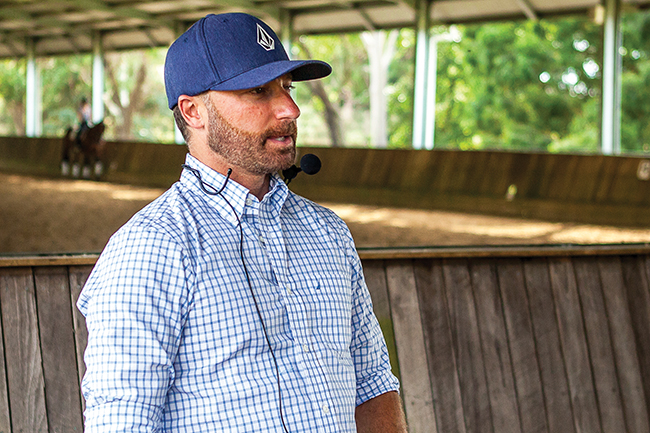 Last month we featured an interview with Jeremy conducted by Rebecca Ashton, now join Rebecca and sit in on a clinic watching the man do what he does best…
Last month we featured an interview with Jeremy conducted by Rebecca Ashton, now join Rebecca and sit in on a clinic watching the man do what he does best…
Sitting in on a Jeremy Steinberg clinic is like going to a university lecture. Jeremy talks A LOT! “You can tell when I’m angry. I stop talking!” he confides. However, there’s method in his ‘madness’. The American sees himself more a teacher, than purely a coach, so explains things as well as possible so his students not only understand what’s happening here and now, but also the background and theory behind it.
Helen Lawson entered the arena with her mare Floryda who was just starting up again after time off and rehab. Even from the start, Jeremy wanted Floryda to understand why she was there. “I’d definitely stretch her at the start, but I would minimise it. I wouldn’t just sit there for too long and let things become stagnant in respect to the horizontal balance. I’d play with little balance fluctuations so it doesn’t get complacent, so later when I try to get her to come up, she will think, ‘Why come up now?’ I would only stay there if the neck was being used against me. That’s way more seldom than we think. With most of them, like her, I wouldn’t. She’s a little horizontal in her balance already.
“I do very, very little long and low in the canter. The canter fluctuates, in a sense, over the wither. The whole body comes up in the croup and lands down in the wither. If I start riding them down, the croup gets higher and higher, and the forehand lower and lower, just because of the nature of the pace. I do it more for a psychological benefit.”
“I would put in a lot of canter/ walk transitions to help rotate the horse’s body. Even in the warmup, you don’t want her to flee her quarters, just sit her into her quarters a bit. Think of the upward rotation of the forehand and the downward rotation of the quarters and give her breaks when she needs them. Does that make sense with the balance? Talk to her about that from the beginning. Especially with her body type, that’s the kind of balance I want from her right from the beginning.”
The walk trot transitions bring up more points of discussion, “No faster than that in the tempo. Slow, swinging, big, high steps. In this speed, I want to drive her hind legs without her speeding off. If I can’t do that without her speeding off, and fleeing the engagement, I won’t ask for more. I’m looking at the relationship between the big stride and the engagement.”
“Just because you put a bit of tension in their body, for example in the walk, it doesn’t have to mean that you’re going to canter,” Jeremy continued, “As soon as she walks, do something like shoulder in or haunches in so she gets busy thinking about that and absorbing those aids rather than what she’s trying to avoid. In the walk, she sucks in, gets tight and starts jigging and she makes you take your leg off, but instead you’ve got to drive it through and out. You have to keep your leg on their tension-loaded body to push it through. Keep your driving aids on and tell her, ‘I’m going to make you loose and through.’”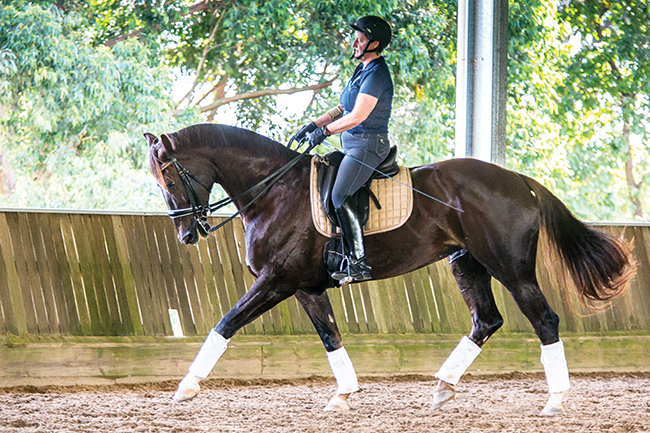
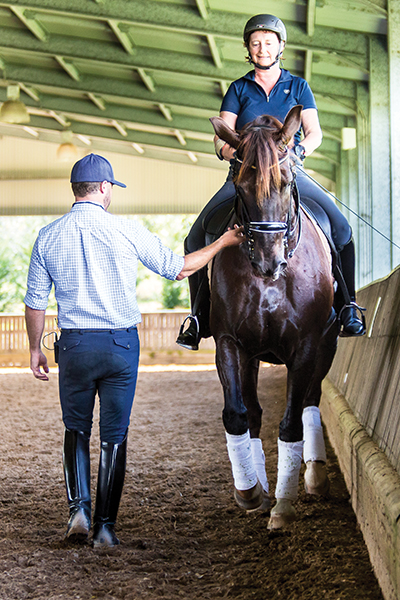
“I’m just walking with her to set the miles, to give her a visual and touch her on the chest just so she sits back, not that she stops.” Jeremy explains what he’s doing to Helen Lawson
“Good. Look at that. Does that make sense keeping the leg on at the walk? If you take the leg off you’re validating the tension. Your body language is then saying there’s something wrong.”
Helen was keen to try some half steps so Jeremy told her how they were going to go about it, “Try to just sit still and enjoy it. Don’t work up there. Less forward. Even less and just sit there and enjoy it. I’m just walking with her to set the miles, to give her a visual, and touch her on the chest just so she sits back, not that she stops. The poll needs to stay nice and high and encourage the hind legs to come backwards. If they’re having a little trouble rotating back, you can rein back. Keep it quiet though. You don’t want the half steps to stay over the shoulder, because later you’ll have problems with the transitions, because she’s a little too weighted in the shoulder. It’s not at all a bad starting place, just know the path you want to take from here.”
Canter was next and it was a similar story to the trot as Jeremy explained, “As much as she’s manageable in front, I would drive those quarters under. The stride becomes shorter, less ground covering, but it becomes higher. I don’t actually shorten it per se, it shortens as a result of the balance change. The power has to lower the quarters and give the forehand lift which lightens the forehand.”
“Take the big stride and nice long even arc of the horse’s body, and start rotating the horse’s body, then the length of stride is smaller. When I go to collect them, if it’s true collection, I’m taking her forehand and shoving it on top of her hind legs. The weight of the body is weighting the hind legs or the other way to look at it is lowering the quarters to allowing the forehand to come up. The forehand should be freer, lighter, higher and more expressive than before. If the tempo slows, it’s just the body getting closer to the ground, rather than the body rotating.”
Mary Houghton is an old hand at Jeremy’s clinics and it was nice to see her horse DP Formidable progressing from last time. She was into the arena and straight into the trot work as Jeremy assessed the combination. There were a few moments in the lateral work that Jeremy wanted to address, “Every day when you do those leg yields, know and set your trajectory. It doesn’t mean that you can’t make variations to that, but HE can’t change it to avoid getting you involved. Don’t let him bulge his shoulder through it.”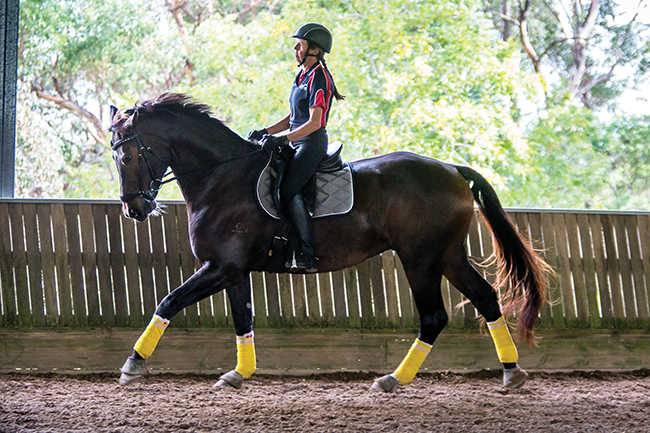
Mary Houghton on DP Formidable
“I wouldn’t do so much shoulder in to haunches in, I’d prefer shoulder in to renvers because every time you swing the haunches around, you’re weighting the forehand as it becomes the stabilising point. You always come into the haunches in from a curved line.”
It was time for a walk break as Jeremy continued his instruction, “There are little places if you taught him to be ok with the whip, you could encourage him to be more under; coil and load the hind legs. It’s not about picking up the whip and start chopping away at the hindlegs, but a quiet tap could help the engagement a little. Some horses have never been abused by the whip, but there’s a little bit of anxiety, and then Mum puts the whip down, so they learn to stay lazy. How they react is not always rational, but it is associated. They are always making associations and connecting the dots. Sometimes it’s not to work harder, but with more fuel efficiency or lazier.
“His shape is better this clinic. Work him like a metal wire….keep playing with it until it fatigues in the middle and breaks (or gives to you, is what Jeremy meant). You keep the frame, but you have to convince him that there’s room for the frame to absorb more engagement of the hind legs.”
“The mile per hour change is not in itself collection, but it’s part of it. Just because the trajectory has changed, the step is higher, but every mph you peel off you want to increase the rpms.”
“He’ll swing his quarters left or right to avoid the work. When you ride forward with a forward thrust from the hind leg, the deviation is more the shoulder bulging left or right, rather than the quarters deviating left or right. They‘ll lean down into the stronger front leg. If you sit them back more, you get more stepping left or right or twisting the body because that’s where you’re transferring the weight. They avoid stepping under the centre of mass.”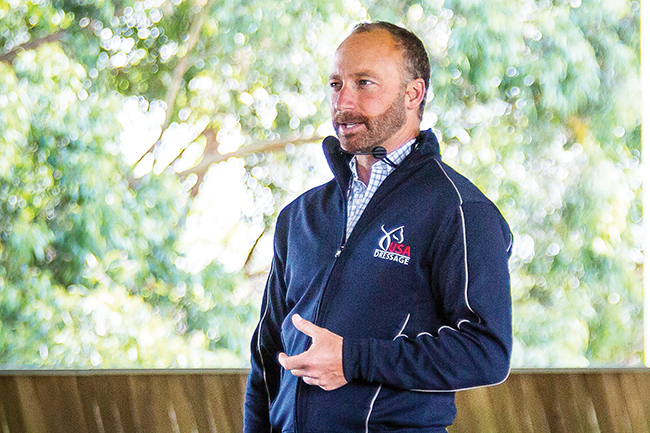
Mary and Formidable were then on to the canter and Jeremy wanted it better still. No one could ever accuse Jeremy of just sitting in the corner saying, “Good. Good.”! “The inside hind leg needs to swing forward under the body. It must not move sideways first.” To remedy this, Mary was asked to ride quarter lines and inside track lines with a little shoulder fore. “When you look in the mirror, I don’t want you to see the inside hind leg to the inside of the inside front leg. Now walk and stay straight. Shoulder-in like. Not extreme. Then he has to canter without losing that position.”
“Yes, it’s tough! He has to learn to use the swing of the hind leg to come under. Really ask him for it, but don’t get so desperate to make him go that you lose all that straightness.”
“The whole use of the lateral work is to get the bend and engagement. It is to get the body to function correctly and allow you access to all the individual parts of his body. It’s isolation work. When we come to the canter and see the deviation of the workload from stepping under and carrying, to instead driving down into one shoulder or stepping sideways with the hind leg to throw the body on an arcing path or a corkscrew instead of straight, we have to ride them into the shoulder-in, for example, to get them to use the body correctly. You want to be able to control those different lateral movements so when you feel a deviation in an area, you can go to that quadrant of the horse’s body and address it.”
The lesson finished with some half steps, and Jeremy made it clear he wanted the horse to remain in front of the leg, “You had a good shape change, but then he sucked it back off the hand and sucked behind the leg. Your job as the rider is to keep him connected. You have to live in this little zone of connecting the hind legs to the front end.”
Mary almost did her job too well and exciting as half steps are, Formidable was getting keen to take over, “He can’t tune out to your half halt. So you halted and that was ok as he got chargey. If I put that charge in his body, I won’t get after him. I’ll tell him it’s not what I want. But if he puts that charge in his body, and is rude, I’ll tell him no.”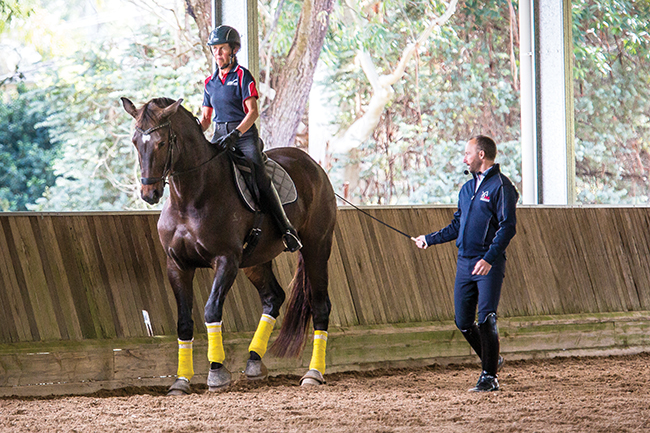
Mary Houghton and DP Formidable work on half steps with Jeremy
“I want to explain further the outward pull of the horse compared to downward pull. I’ll accept more pull in front, but if the balance changes and you get a downward pull, that’s unacceptable.” The horse’s back needs to lift and arc, but know that this takes time. Jeremy doesn’t mind a little pressure out into the hand until the horse gets strong enough to hold it’s correctly lifted back and engaged quarters on its own, but never is the horse allowed to pull the bit down to the ground causing it to be on the forehand. He then picked up a dressage whip to illustrate his point. “The more I squeeze a stick on both ends, the more outward pressure the stick creates on my hands, so I have to be empathetic to that. The whip wants to always go from the arc to straight. The horse is different because it’s made of living, breathing tissue, so it can hold the shape longer as the horse gets stronger, and then the horse needs less outward pressure to hold the shape. But downward press. No.
“Right, now the balance is great and then the transition was good.”
Melinda Hart was next on her gorgeous black stallion Richmond H who has just started out in Grand Prix. After warming up, the combination began work on the half passes. “When the bend gets a little questionable, half pass a few strides then shoulder-in a few strides then half pass. You base the shoulder-in on where and how they’re losing bend. The shoulder-in in the middle is based on that. He likes to get the haunches swinging over too much at the start of the half pass then the angle of the pelvis works in a way that it’s not carrying weight anymore. Make him march the inside hind leg forward in the shoulder-in.”
“There are two trajectories the hind leg is going to take basically. Sideways and forward. The minute you start to go forward, the tangent in the middle where he has to go forward AND sideways is what he’s trying to avoid. He’s happy to do the forward and then the sideways, but not both together. Think more that you want to keep his pelvis perpendicular to the long side as opposed to the angle in the pelvis he’s trying to create.”
Melinda gave it a go but Jeremy still wasn’t 100% happy, “So even though you’re doing half pass, shoulder-in, half pass, the arc of his body is changing relative to the wall. I want the arc of his body to remain the same relative to the wall. Within the shoulder-in stride, feel the inside hind leg to come back under the centre of mass. Feel that you’re going to take the whole shape over, not just the haunches so you stop him swinging them over.”
“You need the half pass to be effective. It’s not effective how you’re doing it, swinging the haunches. Well, it’s suppling a little but it’s not strength building. And that’s what will help the piaffe and passage.”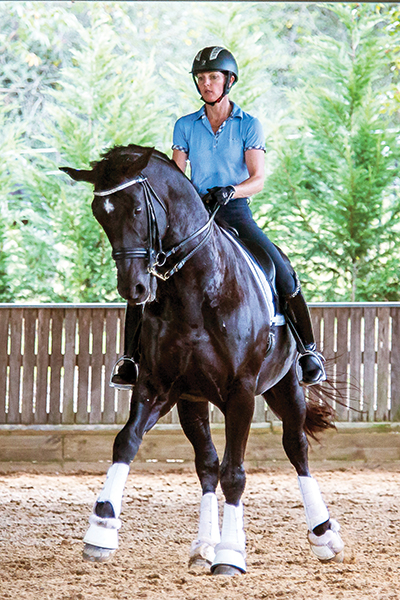
Melinda Hart on Richmond H in canter half pass
When it was time to look at the pirouettes, it was similar instruction. Jeremy wanted a better quality movement, so broke things down and made the progression easier until the horse understood what was being asked of him, “Make a bigger circle with haunches in. This talks to the same principle as the half pass: shoulder fore into the sideways. Watch your tempo. Try to accelerate it a little bit. It’s the rate of repetition of the stride. That can’t slow down when I start my pirouette. The miles per hour will change though. You rode from the straight line right into the pirouette. I would want to ride haunches in first and make sure I own it. Then I’ll take it smaller, and check I own it and keep going until I feel the place where I don’t own it. I’ll stay there for however long I need until I own it again.”
“It’s like when you play music where you may slow down the piece until you can play it, then you play it at the correct tempo. With the horses, you want to keep the tempo, but make the movement bigger, or a little easier until you can ‘play the complex piece’”
Then Jeremy was away again with further explanations, “Horses are fuel efficient creatures. They’re not going to go into an exercise with the highest effort. As long as no one notices, they’ll make it easier. Any flight animal is basically a lazy natured animal because 1: They always need an internal store of energy 2: Their senses are not so good at high speed. Their senses are based on stillness. The wind blowing a smell up their nose, seeing if something is moving. Horses love interaction, but not really work. Predators work in another way. They can use energy because they’ll just take a nap. Horses can’t ,or they’ll die. They live in a very different way. They’re not being a bad horse, it’s just their nature. That’s why I always say, never believe your horse. There’s always a bit in the reserve tanks. Especially stallions and mares, because you have to add ‘reproduce’ to the things they need energy for. However, that doesn’t always give you a right to use that energy! You have to assess the situation.”
Piaffe passage was next, and Jeremy wanted Melinda to really understand how the two are connected and work together. “Creep the hind leg under. Not only do you need to set into him that, so this becomes a self sustaining gait, that’s not your only goal, you then need to shape that into something better and better.”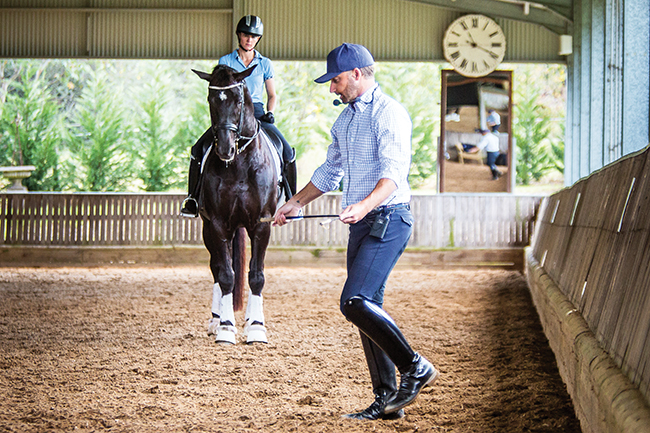
Jeremy explains using a whip to Melinda Hart on Richmond H
“I’m after a smoother transition between piaffe and passage. I’m not going to definitively ride a passage out of that, I’m going to make the piaffe more ground covering, and more ground covering, so I find myself in the passage. What you want to take out of him is the thought of compartmentalising: this is piaffe; this is passage. They need to become the one same concept. I don’t like the shape and the weight loading in his passage. I like it in the piaffe. They do become slightly different things at some stage in the work, but at the moment they’re too different. You want to teach him the passage out of the piaffe rather than out of the trot.”
“Good. Feel his forehand coming up higher? That’s where the passage comes from, that he’s so weight loaded behind giving him the ability to carry the forehand higher. Then they come to life on their own. Don’t be too greedy or they’ll come back to the old way.”
“It’s not the passage, it’s the weight loading and then the travelling, and then you have the feeling you can take off like a plane. That’s the correct, classical way of training rather than bouncing him in the trot, and a year later not being able to get piaffe/ passage transitions, or the judge complaining that the passage isn’t high enough.”
“You have to be careful when you start ‘wham bam’ because he’ll start getting anxious. I’m very sparing with the front leg because you can then disconnect the diagonal pairs. If the front leg does more than the back leg can support, they’ll start dropping their bellies.”
And it wouldn’t be a Jeremy Steinberg clinic without a few position tips. Lisa Just riding Bond 007 had her position focused on, and the first thing to happen was the stirrups were taken away. Then Jeremy ran through all points Lisa needed to focus on as she rode around, “If I ask you to compromise in your body to produce an aid, it’s not the correct aid anyway. Plus you shouldn’t have to drive every stride. Heels down, spurs out. He needs to hold up his end of the bargain.”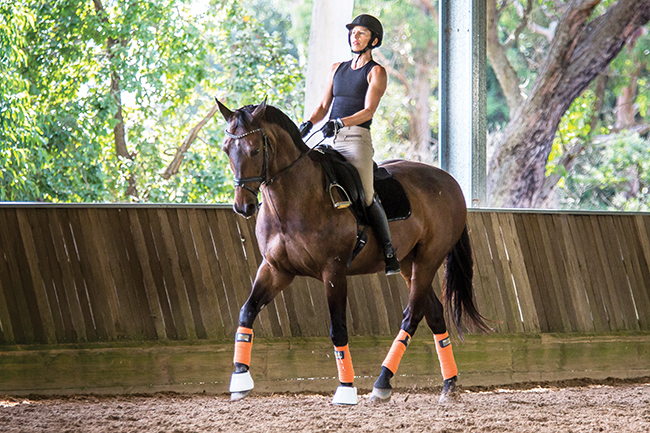
No stirrups for Lisa Just on Bond 007
“Sometimes sitting is easier than rising. I have a scholiosis so I find it easier to sit. When I rise and have to push against the stirrup, my back goes into spasm. If I can sit and drape my leg, I find it easier.”
“There should be no squeezing anywhere. Toe up… that keeps the knee and the ankle angled when you release the knee. Wrap him with your leg from the hip. Rotate the knee. Body tall. Stretch tall through your spine like a ballet dancer. Tummy pulled in.”
“Try not working. Look how much better it gets when you stop working. What holds you in the saddle isn’t working hard, it’s gravity and the swing of your hips. It’s about having all the right angles in the body. It’s not adding to the motion, just following the motion. Your body becomes more still as you become looser, because in the looseness you absorb the movement. There needs to be rigidity to my form, and the angles held in the correct shape so the angles can move correctly. But the movement of his body should move to the absorbent parts of my body. The structure should be very strict, but that form allows for a fluidity of movement. The joints, ligaments and muscles work with the stillness of structure.”
“Now he gets lighter because you’re starting to sit independently. Lift your pubic bone and feel you want to lift it up over the pommel of the saddle. Now your butt is more cemented into the saddle!”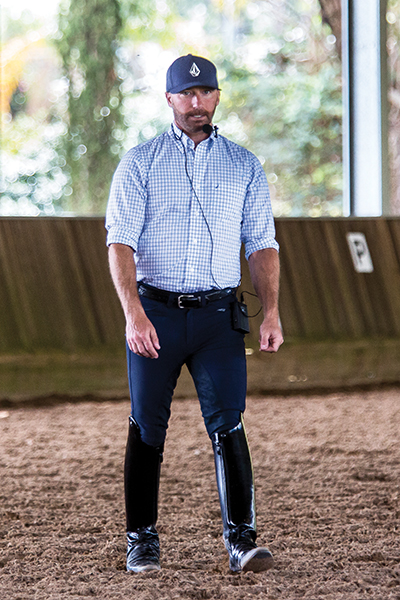
By the end Lisa had been able to produce a much softer position in her body which allowed her horse to lift his frame and move forward more effortlessly.
With so many explanations, descriptions and information, riders and spectators definitely get their moneys worth at one of Jeremy’s clinic. Instead of just repeating the same mantras over and over like some trainers, Jeremy takes ideas, pulls them apart and breaks them down into easy to understand pieces that all the riders can understand fully, and take home to work on day to day. Because let’s face it. it’s the daily doing that reaps the results.


